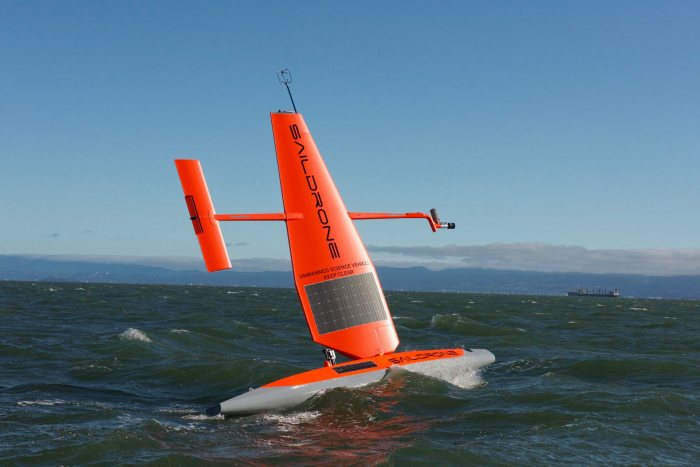
A fleet of unmanned ocean vehicles were unveiled in Hobart on Friday in the lead-up to a couple of the craft undertaking their maiden voyage on Australian waters.
Called Saildrones, their first mission here will be to measure and monitor sea-surface temperature, salinity, ocean carbon, and biota (the plant and animal life of a region) off the coast of Gippsland in Victoria.
A Saildrone is 7 metres long with the height at the top of the solid “sail” (wing) being just under 5 metres. These aren’t particularly lightweight craft, weighing in at around 540 kilograms, including approximately 113kg of payload equipment.
Wind power is used for propulsion (speed: 3 – 8 knots), while solar panels charge the on-board batteries that power Saildrone’s computer, sensor and communication systems. The Saildrone can be remotely controlled through an iPhone app and can stay out at sea for months at a time.
“The fleet of Saildrones may be small in stature, but their ability to autonomously monitor and collect rich streams of data at sea for up to twelve months makes them truly unique in terms of the value they can deliver industry, the research community and ultimately our biggest customer – the nation,” said CSIRO Chief Executive Dr Larry Marshall.
Mission’s Carbon Capture And Storage Connection
A troubling aspect to the first mission is that it’s partly to test and validate technologies used for future carbon capture and storage (CCS) projects. Ocean CCS technology involves pumping captured carbon dioxide emissions beneath the ocean floor into stable geological formations.
If there’s something humanity is very good at, it’s sweeping our dirt under Earth’s rug – which doesn’t always end well. The fact that our oceans are already becoming saturated in CO2, which is turning them acidic, is a cause for concern without the extra risks posed by injecting a bunch more beneath the seabed and hoping that it stays there.
But according to funding partner CO2CRC:
“The Marine Monitoring Network and Seabed Processes will provide certainty to regulators and the community that CCS is safe to the environment in which it operates – specifically marine environments where many storage sites are viable.”
Some suggest CCS, even if it does prove to be viable, is just an excuse to keep on burning fossil fuels and consequently will slow down the transition to renewable energy. Greenpeace calls carbon capture and storage “a costly, risky distraction” and points to a few CCS bloopers.
The Saildrones will leave Hobart in the next few days. Hobart was chosen as the research base as CSIRO intends sending the craft on missions in the Southern Ocean in the future.
These solar energy-assisted unmanned ocean vehicles won’t be the first to conduct a research mission in Australian waters.
In October last year we reported a wave and solar powered craft called WaveGlider had recently completed a deployment in the Great Barrier Reef region, where it gathered data to help assess the health of coral reefs and ecosystems.

 RSS - Posts
RSS - Posts



”
according to funding partner CO2CRC:
”
The Marine Monitoring Network and Seabed Processes will provide certainty to regulators and the community that CCS is safe to the environment in which it operates – specifically marine environments where many storage sites are viable.
”
”
Nothing like rigging “scientific” research, in order to achieve the desired contrived results, and, to destroy the reputation of scientific research.
It kind of reminds me of the fraudulent research into the predetermined harm from thalidomide – thalidomide is harmful, but the scientific research used to prove it, was fraudulent.
It also reminds me of the justification of the illegal invasion of Iraq;
“We will find weapons of mass destruction, even if we have to put them there, ourselves”.
– the justification given by the Trinity of Terrorists (TOTs) – Bush, Blear, and Howard.
True scientific research does not commence with predetermined outcomes – to so do, is nothing short of scientific fraud.
The picture is interesting – it makes me think of Robbie The Robot, surfing.
“Danger, Will Robinson! The carbonic acid levels in the sea, are rising to an unsustainable level, the ocean is acidifying, and it is hurting the sea life! The whales and other sea life are trying to move onto land, to escape the acidification and the other pollution of the sea, by humans!”
(“The oceans of the world have absorbed almost half of the CO2 emitted by humans from the burning of fossil fuels. It has been estimated that the extra dissolved carbon dioxide has caused the ocean’s average surface pH to shift by about −0.1 unit from pre-industrial levels. This is known as ocean acidification”)